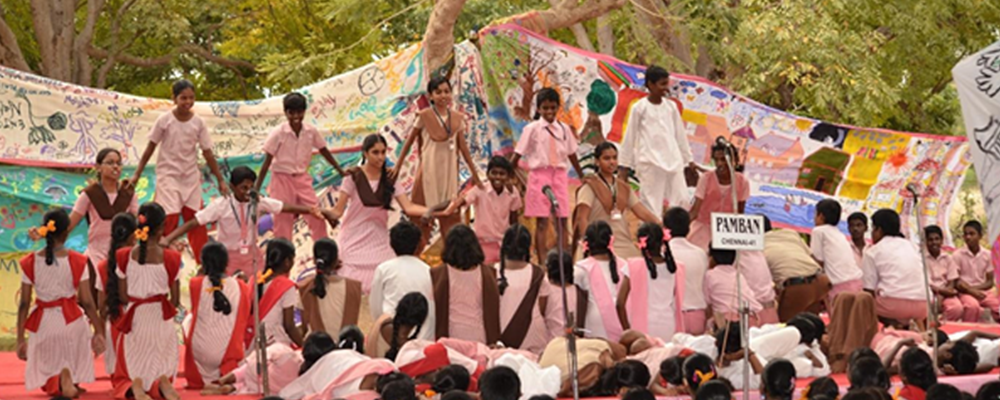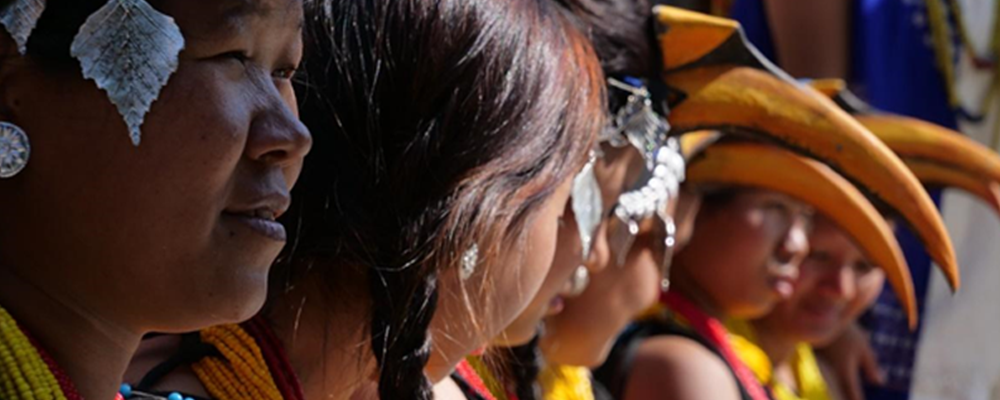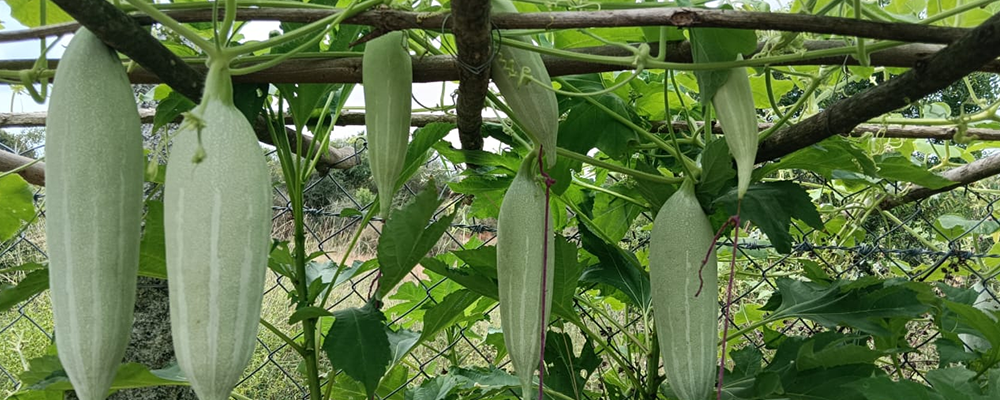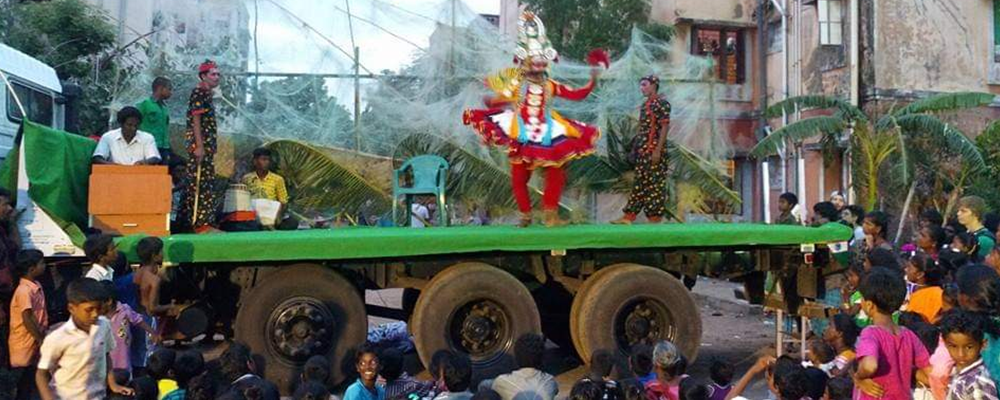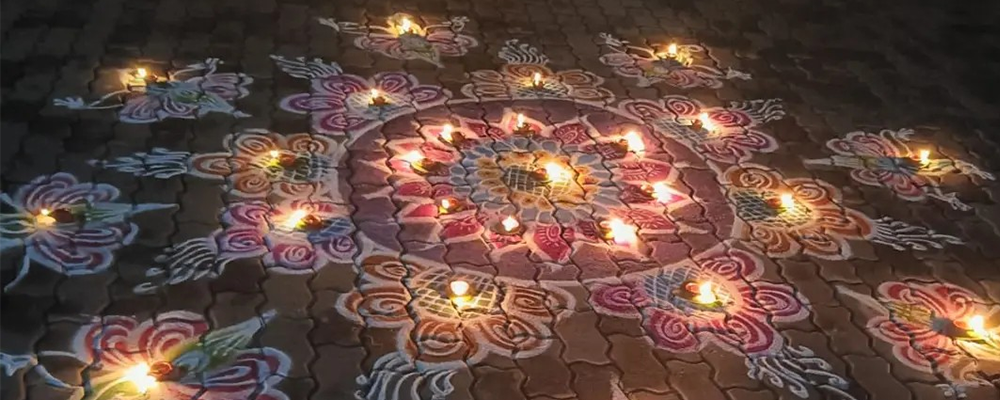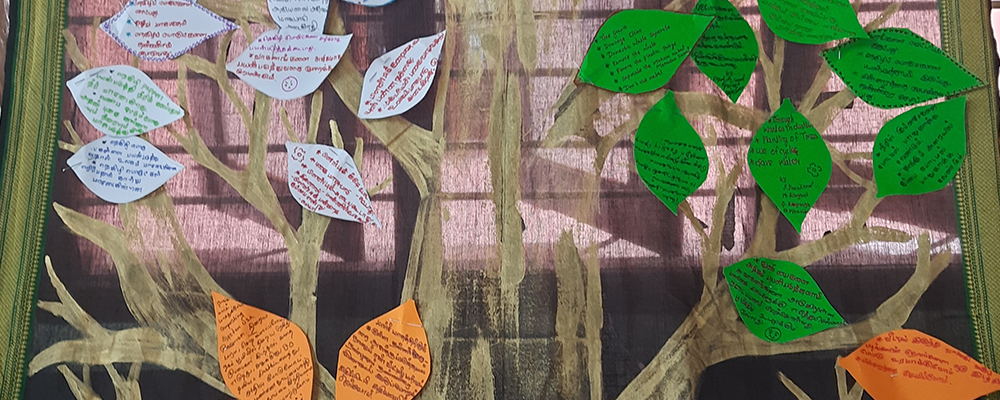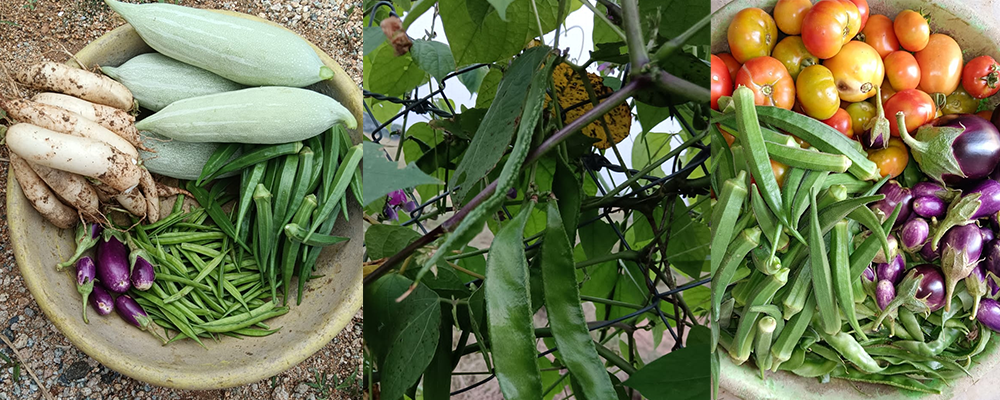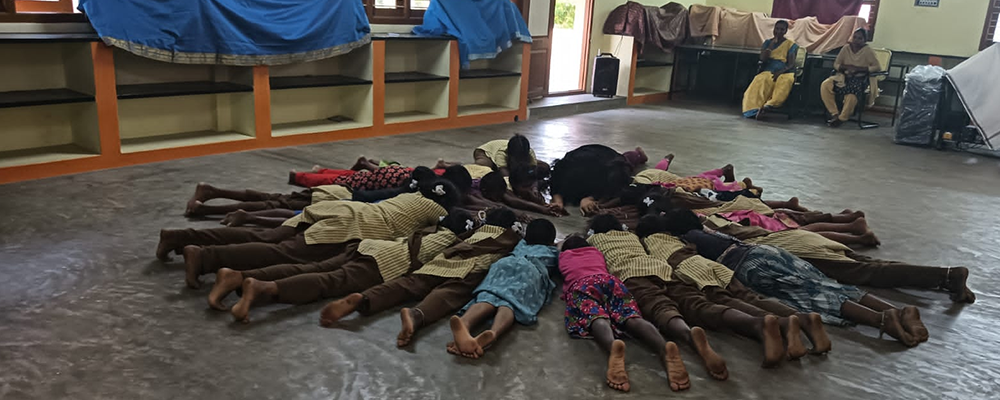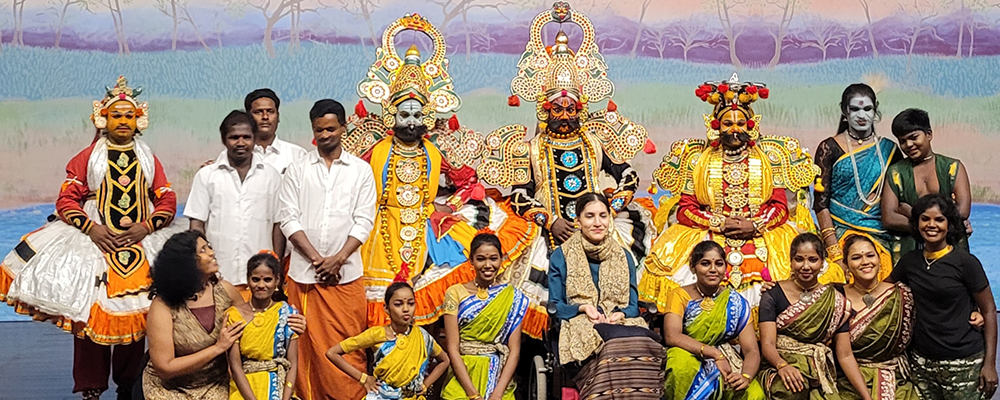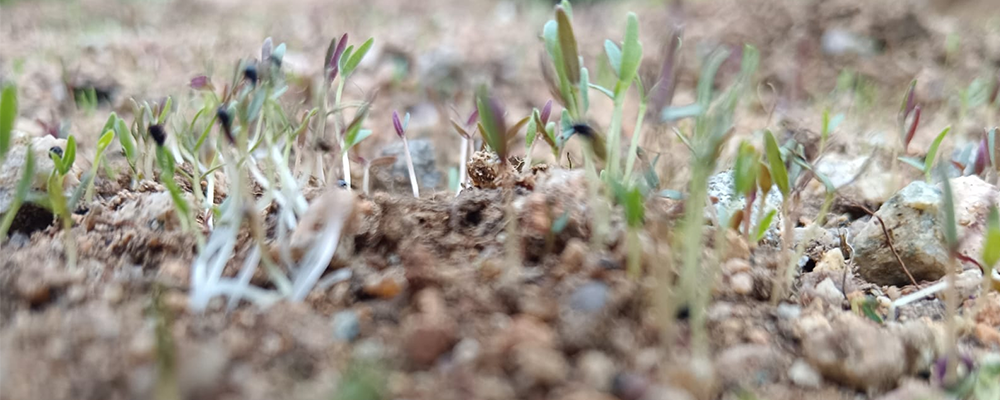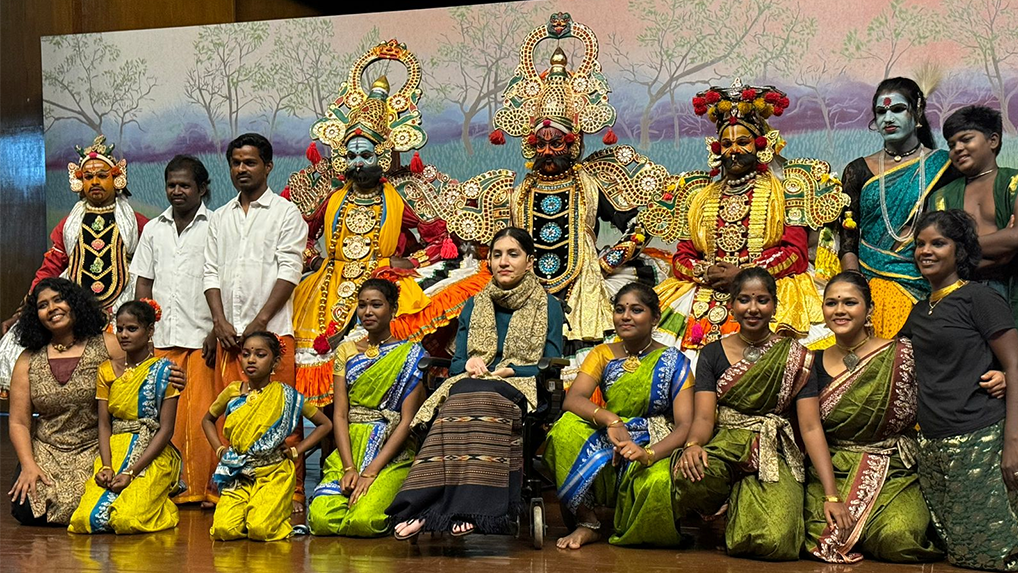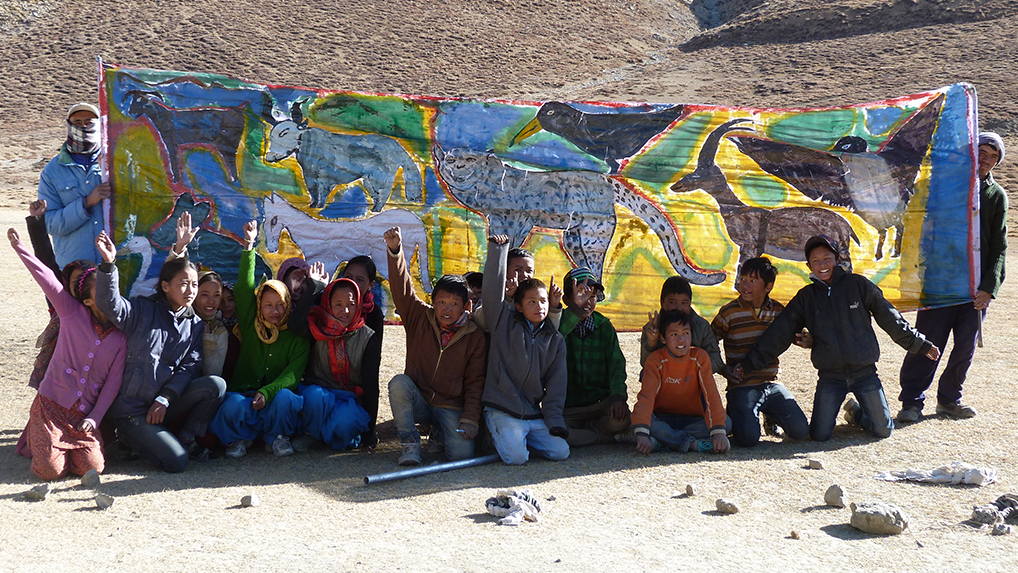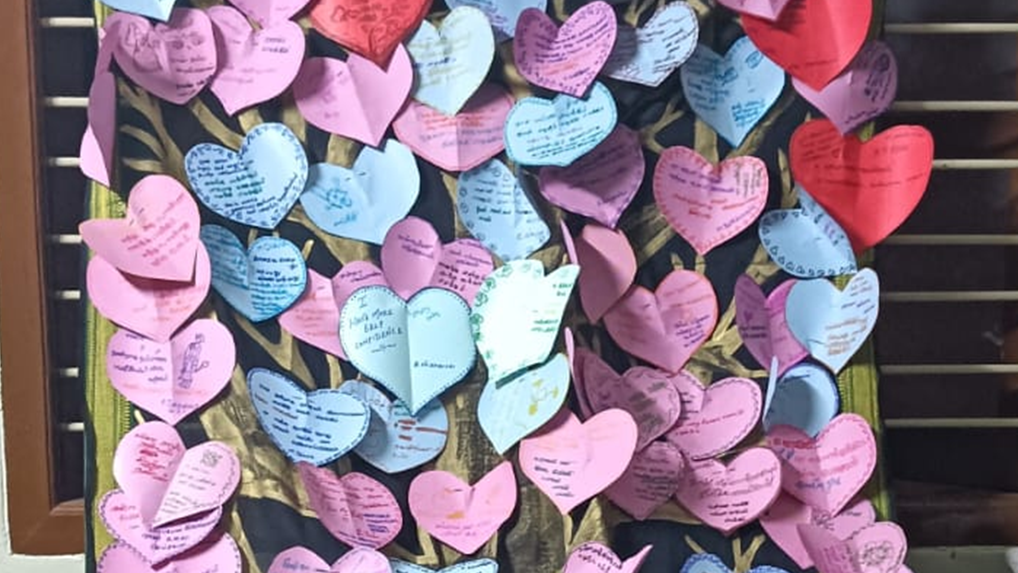Signature Programmes
Manvāsanai: Earth Activism
Manvāsanai, the Tamil word for the fragrance of earth after rainfall (Petrichor in English), is not just a smell, but a radiant feeling. After arid summers, as the first raindrops release this aromatic promise, the scent of the moist earth evokes hope and joy, symbolises fertility and rejuvenation, marking a time of jubilation in rural Tamil Nadu. Sadly, this profound connection with the earth has dwindled. The essence of Manvāsanai is intertwined with our relationship with the earth.
We feel the urgency of environmental degradation and the climate crisis, and have created different projects to address it. But rather than work from a place of anger and despair, we believe in the potency of hope and positivity. Hence, Katradi's activist work for the earth and environment is called Manvāsanai - the scent of hope, the promise of change. We are driven by the conviction that change is attainable, and we can forge a better, more sustainable bond with the earth; working with four different, yet interconnected, strategies:
Over the years, Sangeeta Isvaran has worked in a variety of landscapes - in the Himalayan ice deserts over 5000m altitude, in the plains, in rainforests, coastal landscapes, urban slums, villages - with tribal and backward caste communities (the categories as designated by the Indian government) on themes of community-based conservation, nature education, climate disasters, livelihood development, waste management, the three Rs - Reduce, Reuse, Recycle and more. Working with NGOs such as Nature Conservation Foundation (NCF), Pudiyador, Wildlife Conservation Society - India (WCS - India) and her own NGO, Wind Dancers Trust - Katradi, she designs different projects according to the needs of the landscape and community.
1. Art Advocacy for Earth
At Katradi, we draw on the power of traditional performance arts - many of them endangered or marginalised - to advocate for the environment and reconnect people with nature. Through theatre, dance, and movement-based events, we shine light on urgent ecological issues. Over the years, we have created several performances and arts-based projects, with schools, community spaces and other organisations, that trigger vital conversations on environmental themes. Below are some of our most impactful initiatives.
i. Shhh… Listen!
"Shhh… Listen!" is a powerful, multidisciplinary performance on one of the most urgent challenges of our time: climate change and the destruction of wetlands. Commissioned by the Student Conference on Conservation Science (SCCS) to mark their 15th anniversary, the play premiered in 2024 at the IISc Auditorium, Bangalore, for an audience of nearly 500 conservationists and students.
Unlike most conservation narratives that focus on forests and charismatic species, “Shhh… Listen!” draws attention to frogs, dragonflies, sandpipers, and marshland plants - fragile yet vital beings that sustain ecosystems, regulate water, and protect communities. The story celebrates the life of an urban wetland until destruction descends: garbage, effluence, bulldozers. The performance confronts grief and rage, but also carries a call to action - to see wetlands not as wastelands, but as incredible ecosystems.
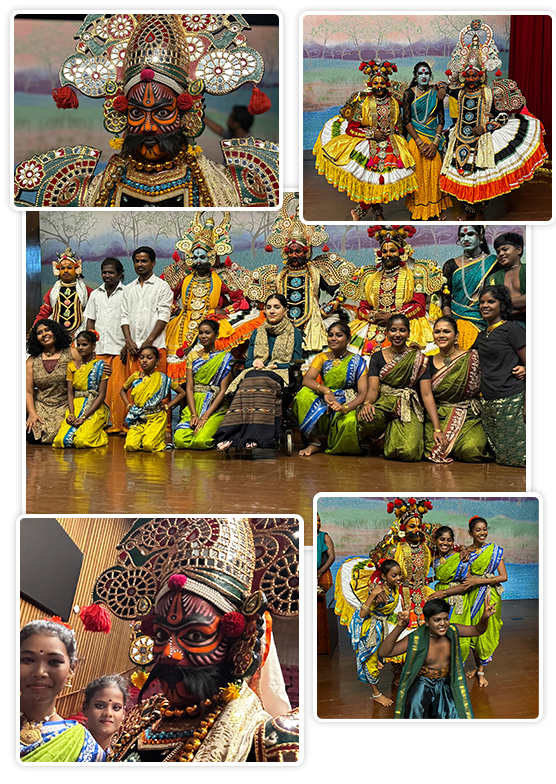
Blending Kattaikkuttu, Parai, Oyilattam, Oppari, and Bharatanatyam, the play uses living traditions to embody both vitality and loss. Performed by artists from marginalised backgrounds, whose own voices are often overlooked like the creatures they portray, "Shhh… Listen!" is both representation and resistance. Its flexibility allows the play to adapt to conferences, festivals, and community spaces, remaining contextually relevant and deeply resonant. Accessible across languages through music, movement, and imagery, the play transcends barriers and urges us to listen - not only to wetlands, but also to the silences left behind when ecosystems collapse.
Over time, "Shhh… Listen!" has taken many forms, performed by the Katradi Youth Dance Theatre and narrated by disability activist Shrilakshmi Sridhar. Today, the play is being carried forward in a serious way by our Katradi Youth Dance Theatre - a collective of highly talented youngsters trained in marginalised art forms. Many of them have participated in workshops on nature, are actively exploring the landscapes around their village, and are deeply committed to protecting the environment.
Over time, "Shhh… Listen!" has taken many forms, performed by the Katradi Youth Dance Theatre and narrated by disability activist Shrilakshmi Sridhar. Today, the play is being carried forward in a serious way by our Katradi Youth Dance Theatre - a collective of highly talented youngsters trained in marginalised art forms. Many of them have participated in workshops on nature, are actively exploring the landscapes around their village, and are deeply committed to protecting the environment.
Quotes from Audience Members:
“I never thought that traditional Kattaikkuttu could be used to portray a JCB, representing the forces of greed that destroy nature's balance.”
“The scene of the destruction of this delicate ecosystem brought me to tears.”
“Wetlands are wastelands only from the perspective of human beings, not the environment.”
ii. Nyolo Tuki - the Dirge of the Hornbills: An exceptional example of conservation in action.
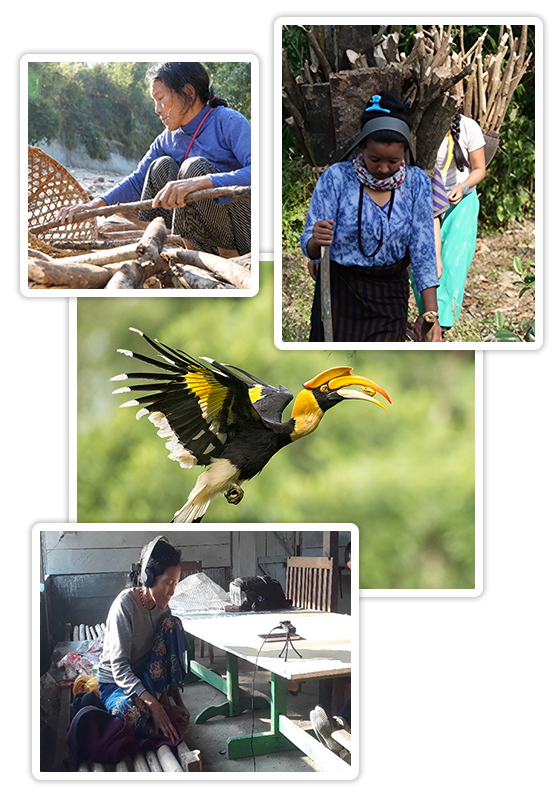
Culture and nature conservation go hand in hand. When we focus on conserving forests and natural landscapes, particularly while collaborating with indigenous communities residing in those areas, we discover that their songs, stories, and art are deeply interconnected with the environment. The trees, flowers, animals, and birds present in these landscapes inspire their creativity and form an integral part of their cultural heritage. Therefore, in our efforts to conserve nature, we find the essence of culture embedded right within the landscapes we seek to protect.
Background:
In 2016, Sangeeta Isvaran began working with the Nature Conservation Foundation (NCF) in Pakke Tiger Reserve in Arunachal Pradesh, in the Northeast of India, with the Nyishi tribe. NCF runs a Hornbill programme there, along with other projects, to help this species on the verge of extinction. The Nyishis, who traditionally wear cane helmets surmounted by the crest of a hornbill beak, have damaged the population of this bird, killing them for the beaks.
Several efforts have been made trying to stop the Nyishi hunting these birds in order to protect them from extinction. The Hornbill Nest Adoption Program (HNAB) has been going on since 2011, which is a community led conservation initiative through which local tribal villagers protect nest trees of hornbills in forests around villages on the fringe of the Pakke Tiger Reserve. The hunters from the Nyishi tribe are now protectors who try to save the hornbill population.
Several efforts have been made trying to stop the Nyishi hunting these birds in order to protect them from extinction. The Hornbill Nest Adoption Program (HNAB) has been going on since 2011, which is a community led conservation initiative through which local tribal villagers protect nest trees of hornbills in forests around villages on the fringe of the Pakke Tiger Reserve. The hunters from the Nyishi tribe are now protectors who try to save the hornbill population.
The hornbills' life cycle is very interesting - they are monogamous and many species mate for life. Hornbills nest in the cavities of tall trees. Once the female picks the nest, she locks herself within the cavity by covering the opening with mud, barks, excreta, saliva, etc. She leaves a small opening to receive food. The male hornbill collects food for his female and the young one. During this breeding season, the female and young are completely dependent on the male for their survival till the juvenile reaches a mature state. If the male bird dies during this breeding season, it will also result in the death of the female and young ones.
Through 2016 and 2017 Sangeeta worked with the Nyishi Tribal women, on livelihood development and gender equality. She met Mema Tok, an incredible 80-year-old Nyishi woman who was the keeper of the traditional songs of her tribe. Songs that she had not passed on to the younger generation since nobody was interested anymore. The first time they met, Mema Tok sang Nyolo Tuki, a dirge about a woman whose husband is missing; she goes hunting for him through the forest and finally finds his dead body. This lament is located in the emotional and physical landscape of their rainforest referring to trees, plants, animals, different kinds of traps and other details of their daily life. It was amazing! When Sangeeta listened to this song, she realised we could tell the story of the hornbills through this song.
Performance for the Pakke Paga Festival
The Nyishi women's group Sangeeta worked with were invited to perform for the Pakke Paga (hornbill) Festival in 2018. And we decided to become hornbills and create their love story.
Researching into traditional dance, music and folklore we created the love story of a pair of hornbills. After the female seals herself in the nest, their baby is born. But one day the male is killed by hunters, trying to protect her. She waits and waits and soon the baby dies of hunger. She breaks free of the nest and like the woman in Nyolo Tuki, she goes searching for her love through the forest and finally finds him dead. The haunting dirge brought many to tears.
This project helped document songs that might soon be lost and at the same time raises awareness of the plight of the hornbills - cultural conservation and nature conservation. It's easy in this context because the Nyishi used to live in harmony with their beloved forest until recently. Drawing on their poetry, their symbolism and imagery through Nyolo Tuki, we strike the heart of the Nyishi people with the message that hornbills are no different from us in love and loss and we need to work to save their species. Guilain Roussel, a French landscape artist and filmmaker, came to Arunachal Pradesh in the final phase of the project to record Mema Tok as well as make a film about the song.
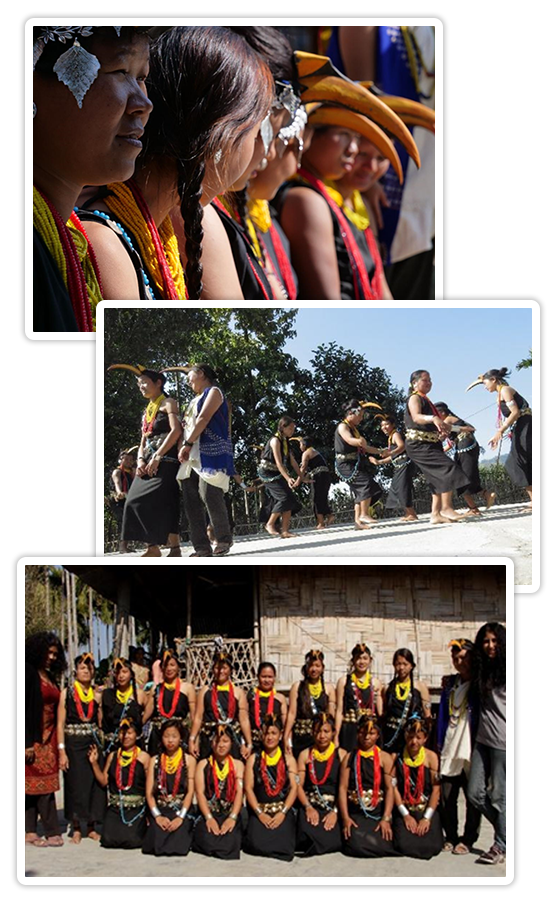
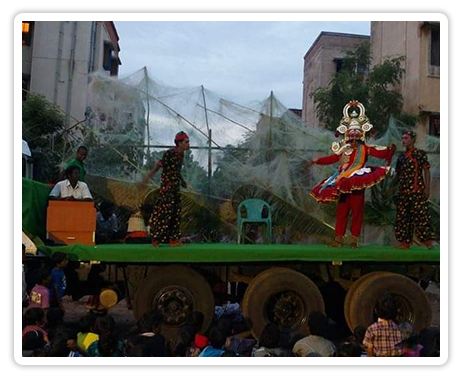
iii. Mega Lorry Lolakku 2015: Microhistories of Madras
In August 2015, as part of Madras Week, Katradi embarked on a project to highlight the rich stories of the fisher villages known as "kuppams" along the Chennai coastline. Despite their historical significance predating Madras itself, these villages have unfortunately become associated with poverty and violence. To challenge this perception, Katradi collaborated with Les Poussières, a French theater group, to work with these communities using Kattaikkuttu, Bharatanatyam, photography, graffiti art, installation art and innovative sound technology. Click Here to read more.
2. Nature Conservation in Partnership with Large Organisations: NGOs like NCF-India and WCS-India
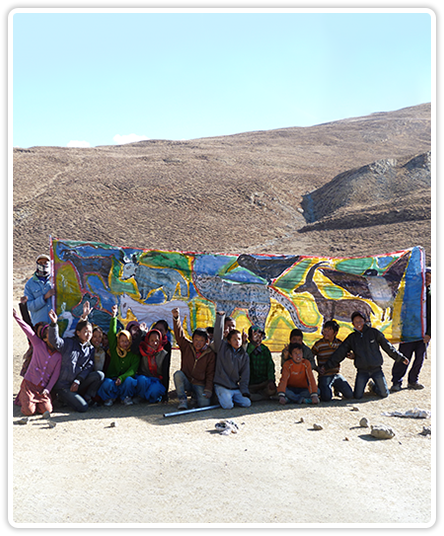
i. Nature Education
In our efforts towards nature education, we collaborated with the Nature Conservation Foundation (NCF), particularly their High Altitude Programme, in Spiti Valley. Through youth camps, we provided children with immersive experiences to foster a deep connection with their environment and landscapes. These play-based modules encouraged exploration of all senses, promoting a profound understanding of interconnectedness among all living beings. As part of this collaboration, we conducted a "Training of the Trainers" session, focused on enhancing strategies for working effectively with communities. Our approach addressed critical issues such as gender and caste, ensuring equitable representation of all voices. By fostering inclusivity, we aimed to create a more impactful and sustainable conservation approach. Furthermore, in partnership with the Snow Leopard Foundation in Kyrgyzstan, we conducted a research project that incorporated traditional games and folklore into their nature education programme.
ii. Team Building
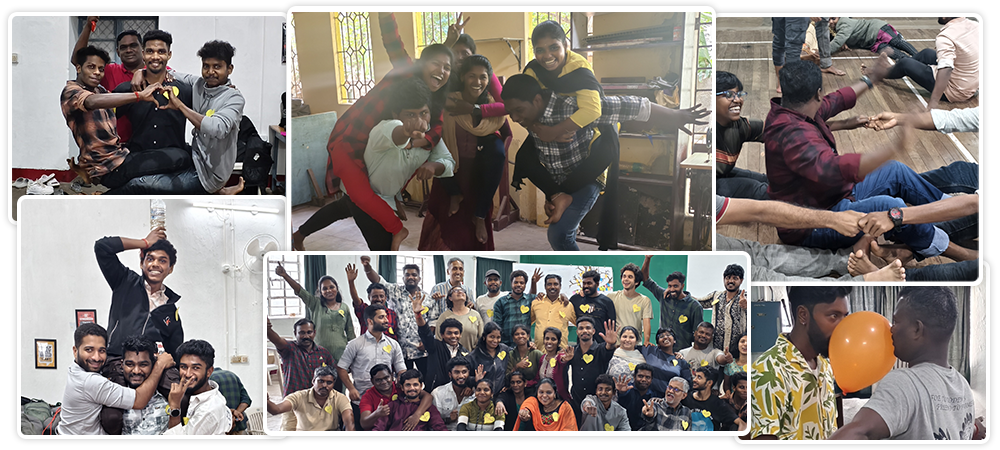
Conservation NGOs work diligently in challenging terrains and diverse cultural contexts to protect the environment. However, they may overlook social prejudices within their teams, such as gender and caste biases and disparities in educational backgrounds. This is where we step in. To enhance team performance and bolster effective conservation efforts, it is vital to invest in creating a just and equal team. This includes addressing issues of safety for women and promoting inter-gender communication awareness to ensure a respectful and harmonious work environment.
iii. PoSH
With the PoSH (prevention of sexual harassment) act in force, all organisations, including NGOs, must comply with the law. Sangeeta Isvaran specialises in developing modules to help large teams comprehend not only the letter of the law but also its implications. Her modules cover topics like reasons why individuals may not report incidents, the potential consequences of reporting, and the emotional distress associated with perceived harassment. The goal is to create a safer and more inclusive work environment for all, fostering an atmosphere where they feel supported and protected.
By promoting better communication, conflict resolution, and mental health support, teams can become more cohesive and effective. This will enable them to tackle conservation challenges while actively avoiding the perpetuation of generational injustices.
During one such workshop, a senior participant from a prominent NGO made this comment which expressed resistance to addressing gender-based issues alongside conservation efforts. However, after three days of discussions and learning, he had a change of heart. He realised that having basic ethics in place and addressing injustices within the team not only strengthened their strategies for working with diverse communities but also aligned with the organisation's commitment to ethical behavior. This transformation highlighted the importance of inclusivity and ethical values in achieving a more robust and impactful mission.
3. Environment & Climate Change Curriculum
We believe environmental action begins with awareness and connection. That is why we have developed a curriculum that uses our nature-based art forms to help children and communities understand their relationship with the earth. Most of the underserved communities we work with are directly impacted by climate change, yet the concept itself is often unfamiliar. In many Indian languages, there isn’t even a word for it. Through storytelling, movement, and creative practice, we make these ideas accessible, build consciousness around waste management and plastics, and inspire practical action rooted in the principles of Reduce, Reuse, Recycle. We are committed to taking it to many more communities across India.
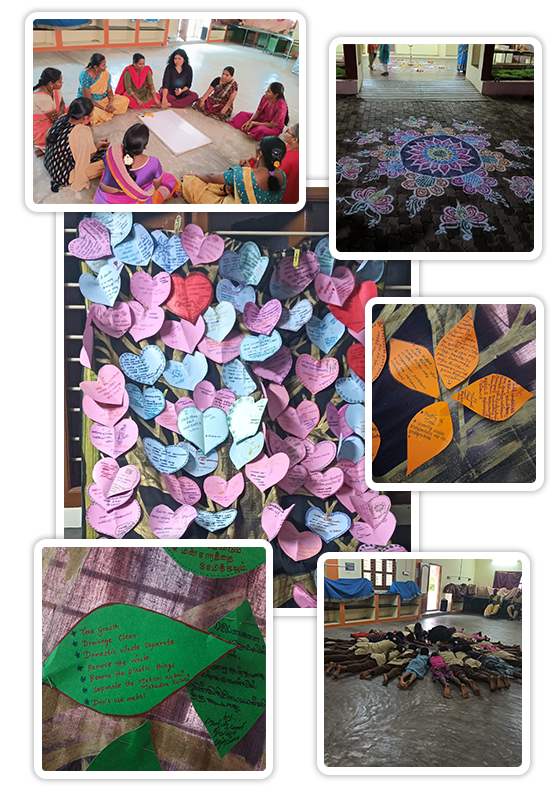
i. Project Empower Her - In Collaboration with Omega Forum for Social Impact (OFSI):
At Sri Lalitha Mahila Samajam, a children’s home in Trichy, Katradi worked with the girls and staff to build environmental awareness through dance, theatre, games, and participatory discussions. The programme introduced them to the connections between food, nutrition, sustainability, and climate change.
Through creative sessions, the children explored balanced diets, the cycle of life, and the urgent challenges of waste management. They practiced waste segregation, learned composting techniques, and embraced the mantra of Reduce, Reuse, Recycle. Most importantly, they set tangible goals for themselves, from starting compost pits and separate bins to reducing water, electricity and plastic use in their daily lives.
By combining art with practical learning, the workshops went beyond awareness, nurturing sustainable habits and real change within the children’s home and their wider community.
ii. The Goddess of the Sea - Climate Change and its Impact on Fishing Communities
Pudiyador is an NGO that runs after-school centres in slums in Chennai. We created an urban garden in one of their beach centres where children from the local fishing communities come every evening. We also created an ocean scape using recycled materials to talk about how climate change has affected their community of fishing people. This exhibition created by the kids was premiered during the 10-day festival of the Mother Goddess in the form they worship. Using this powerful symbolism had a huge impact on the children and the surrounding community. For 10 days we welcomed scientists, waste management specialists, and conservationists to talk to the children; we carried out flash mobs and cleaning activities in the streets around the centre, we spoke about composting and plastic waste, and began to plant our urban garden which went on to flourish for a while.
“Can I kiss Mother Earth? I think she must be very sad…”, asked Vignesh, one of the children Sangeeta worked with. That led our conversation to all the hope we have to heal ourselves and the earth.
Our workshops are filled with laughter and positive energy - much needed in these times of uncertainty. Children form the centre of most of our activities because they are the ones who are going to change the world! And they will, with our support, they can show us the way!
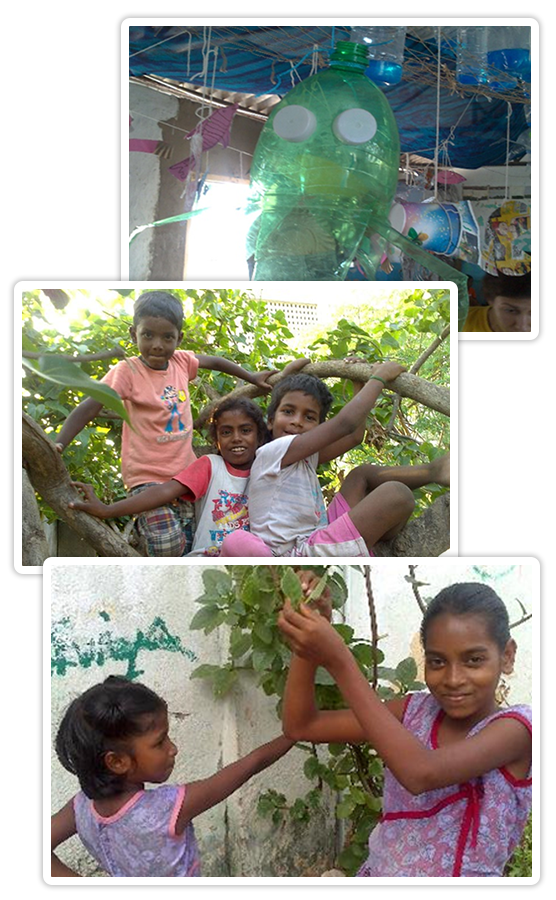
4 Sustainable Living Practices
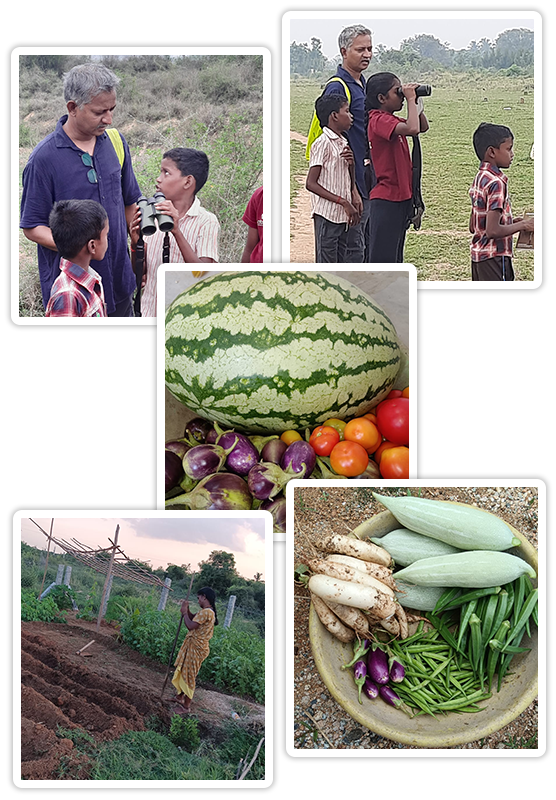
The Katradi Centre, situated in Kalavai Kootroad, serves as a space for children from nearby Dalit villages to learn various art forms and receive education on their rights, child sex abuse and reproductive health. Additionally, we've expanded our programme, connecting communities with the environment.
At the height of the pandemic when schools were closed for two years, our team relocated to Kalavai Kootroad and the Katradi Centre became a de facto school as village children lacked the necessary devices for online classes. Additionally, the centre transformed into a vital hub for distributing rice bags, combating poverty, conducting medical camps, and collecting essential medical supplies. To address the issue of children missing out on their midday meals during school closures, we initiated a free kitchen until we motivated the government to provide additional rations to families as a compensatory measure. The free kitchen continued to operate on weekends until 2024 to address issues of malnutrition and its health implications among the children.

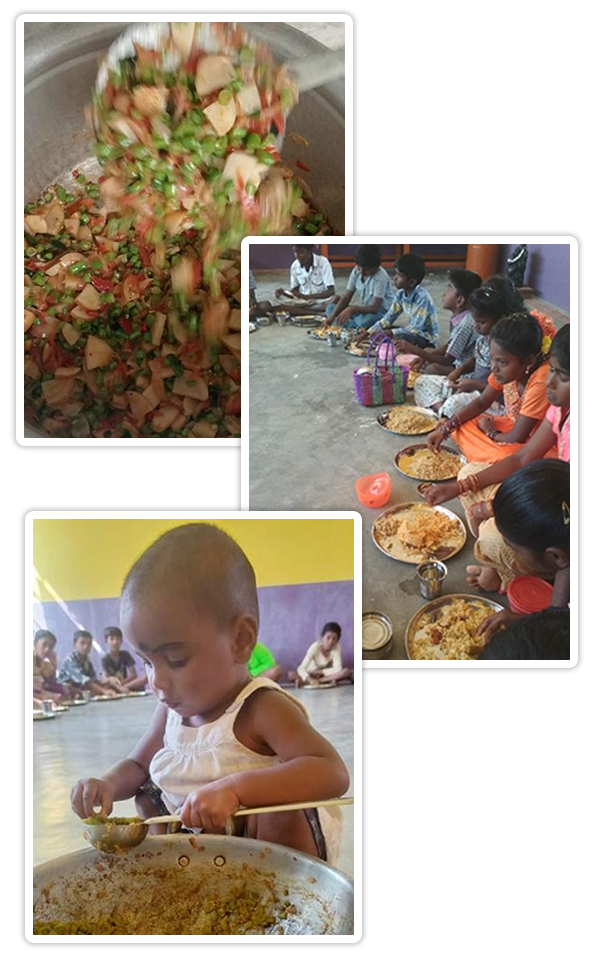
Expanding our initiatives, we acquired a small plot adjacent to our centre. We are currently preparing the soil to establish an organic garden that will supply fresh vegetables for our kitchen and the local community. Embracing sustainable living, we want to grow our own food and prioritise minimal electricity usage. Our focus is on developing a curriculum that educates the children about the impact of our life choices on the world around us. Through this approach, we aim to instill a sense of responsibility and consciousness towards the environment, fostering a lifestyle of sustainability within our means.
We initiated ISIRI - the Fellowships of Joy, comprising 5 young women who have endured various experiences of gender violence, abuse, and discrimination. Each fellow specialises in a unique form of art, leveraging it to engage with children on diverse topics such as gender equality, caste discrimination, self-defense for girls, climate crisis, waste management, and more. One of our fellows, Sujitha, an organic Gardener, is going to work on the environment and climate issues in her village.
We regularly invite experts and specialists to our centre to deepen the children’s understanding of nature and sustainable living. Alongside these sessions, our environment and climate change curriculum has been woven into their everyday learning, ensuring that sustainability is not just taught, but actively practiced in their lives.
i. Workshops at the Centre
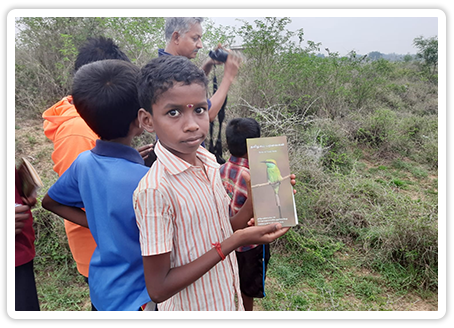
Birdwatching workshop: We hosted Mr. Jegan, a senior scientist with the Nature Conservation Foundation (NCF), who conducted a bird watching workshop that mesmerised children with the wonders of nature. This experience extended beyond bird species introduction, immersing them in the beauty of their evocative Tamil names. Many of the younger boys at our centre had the habit of killing little birds and lizards with sound and stones. Our mission was to nurture empathy and a deep bond with the surrounding environment.

